Providence, Rhode Island, Hgh State Clinic, Hgh Injections, Hrt Doctors
Providence, Rhode Island Blood Testing Facilities

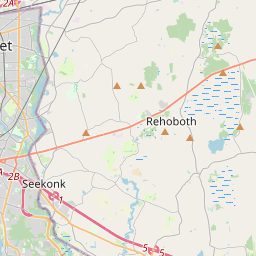
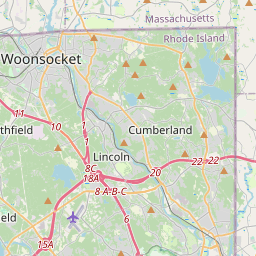

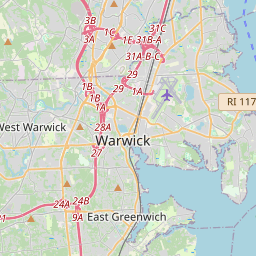















 Represents a LabCorp blood testing facility
Represents a LabCorp blood testing facility Represents a Quest Diagnostics blood testing facility
Represents a Quest Diagnostics blood testing facility

Nearby Labcorp Blood Testing facilities:
- Labcorp Center Distance: 1 m, 756 Eddy St Suite 101, Providence, Providence County, RI, 2903
- Labcorp Center Distance: 26 m, 966 Park St Unit B7, Stoughton, Norfolk County, MA, 2072
- Labcorp Center Distance: 29 m, 72 Cudworth Rd, Webster, Worcester County, MA, 1570
- Labcorp Center Distance: 36 m, 21 Eastern Avenue Suite G2, Worcester, Worcester County, MA, 1605
- Labcorp Center Distance: 38 m, 140 W Boylston Dr, Worcester, Worcester County, MA, 1606
- Labcorp Center Distance: 39 m, 6 Lexington St 2Nd Floor, Waltham, Middlesex County, MA, 2452
- Labcorp Center Distance: 40 m, 12 Case St Ste 302, Norwich, New London County, CT, 6360
- Labcorp Center Distance: 62 m, 200 Sutton St Ste 135, North Andover, Essex County, MA, 1845
- Labcorp Center Distance: 65 m, 380 Merrimack St Ste B2, Methuen, Essex County, MA, 1844
- Labcorp Center Distance: 66 m, 25 Pelham Rd Ste 103A, Salem, Rockingham County, NH, 3079
- Labcorp Center Distance: 67 m, 2284 Berlin Turnpike, Newington, Hartford County, CT, 6111
- Labcorp Center Distance: 68 m, 49 Range Rd Ste 101, Windham, Rockingham County, NH, 3087
- Labcorp Center Distance: 78 m, 101 Riverway Pl, Bedford, Hillsborough County, NH, 3110
- Labcorp Center Distance: 82 m, 3018 Dixwell Ave 3Rd Fl, Hamden, New Haven County, CT, 6518
- Labcorp Center Distance: 83 m, 19 Hampton Rd Ste 13, Exeter, Rockingham County, NH, 3833
- Labcorp Center Distance: 87 m, 1068 W Main St, Waterbury, New Haven County, CT, 6708
- Labcorp Center Distance: 88 m, 755 Campbell Ave Ste 3, West Haven, New Haven County, CT, 6516
- Labcorp Center Distance: 89 m, 887 Old Country Rd Ste C, Riverhead, Suffolk County, NY, 11901
- Labcorp Center Distance: 90 m, 875 Greenland Rd Orchard Park, Portsmouth, Other, NH, 3801
- Labcorp Center Distance: 91 m, 230 Lafayette Rd Bldg D, Portsmouth, Rockingham County, NH, 3801
- Labcorp Center Distance: 98 m, 45 Route 25A Ste E2, Shoreham, Suffolk County, NY, 11786
- Labcorp Center Distance: 99 m, 750 Central Ave Ste E, Dover, Strafford County, NH, 3820
Nearby Quest Blood Testing facilities:
- Quest Center Distance: 0 m, 1 Randall Sq, Providence, Providence County, RI, 02904-2709
- Quest Center Distance: 15 m, 101 President Ave, 1St Floor, Fall River, Bristol County, MA, 02720-2652
- Quest Center Distance: 18 m, 10 Commercial St, Foxboro, Norfolk County, MA, 02035-2509
- Quest Center Distance: 25 m, 237 State Rd, North Dartmouth, Bristol County, MA, 02747-2612
- Quest Center Distance: 26 m, 335 Morse St, 1St Floor, Norwood, Norfolk County, MA, 02062-5034
- Quest Center Distance: 28 m, 210 Quincy Ave, Brockton, Plymouth County, MA, 02302-2864
- Quest Center Distance: 31 m, 61 Lincoln St, Framingham, Middlesex County, MA, 01702-8264
- Quest Center Distance: 32 m, 340 Wood Rd, Suite 302, Braintree, Norfolk County, MA, 02184-2410
- Quest Center Distance: 33 m, 851 Main Street, S. Weymouth, Norfolk County, MA, 02190-2409
- Quest Center Distance: 34 m, 500 Congress St Ste 1E, Quincy, Norfolk County, MA, 02169-0908
- Quest Center Distance: 36 m, 100 Mlk, Jr. Blvd, Worcester, Worcester County, MA, 01608-1220
- Quest Center Distance: 38 m, 319 Longwood Ave, Boston, Suffolk County, MA, 02115-5728
- Quest Center Distance: 39 m, 57 Long Pond Rd, Plymouth, Plymouth County, MA, 02360-2670
- Quest Center Distance: 40 m, 55 Town Street, Norwich, New London County, CT, 06360-2332
- Quest Center Distance: 41 m, 135D Storrs Rd, Mansfield Center, Tolland County, CT, 06250-1638
- Quest Center Distance: 42 m, 22 Mill Street, Suite 107, Arlington, Middlesex County, MA, 02476-4738
- Quest Center Distance: 45 m, 350 Gifford St Ste 15-17, Falmouth, Barnstable County, MA, 02540-2918
- Quest Center Distance: 48 m, 721 Bank Street, New London, New London County, CT, 06320-5005
- Quest Center Distance: 51 m, 15 Chesterfield Road, East Lyme, New London County, CT, 06333-1730
- Quest Center Distance: 52 m, 79 Erdman Way, Leominster, Worcester County, MA, 01453-0000
- Quest Center Distance: 53 m, 39 Village Square, Chelmsford, Middlesex County, MA, 01824-2743
- Quest Center Distance: 54 m, 520 Hartford Turnpike, Vernon, Tolland County, CT, 06066-0000
- Quest Center Distance: 55 m, 180-182 Endicott Street, Danvers, Essex County, MA, 01923-0000
- Quest Center Distance: 56 m, 700 Rogers Street, Lowell, Middlesex County, MA, 01854-3571
- Quest Center Distance: 57 m, 555 Main Street, Manchester, Hartford County, CT, 06040-5196
- Quest Center Distance: 59 m, 69 Camp Street, Hyannis, Barnstable County, MA, 02601-0000
- Quest Center Distance: 60 m, 100 Hazard Ave, Enfield, Hartford County, CT, 06082-5447
- Quest Center Distance: 61 m, 131 New London Turnpike, Glastonbury, Hartford County, CT, 06033-2246
- Quest Center Distance: 62 m, 665 Boston Post Road, Old Saybrook, Middlesex County, CT, 06475-1521
- Quest Center Distance: 64 m, 300 Main St, Nashua, Hillsborough County, NH, 03060-4635
- Quest Center Distance: 65 m, 45 Stiles Rd Ste 102, Salem, Rockingham County, NH, 03079-2850
- Quest Center Distance: 66 m, 21 Woodland St, Hartford, Hartford County, CT, 06105-4318
- Quest Center Distance: 67 m, 62 Brown Street, Haverhill, Essex County, MA, 01830-6790
- Quest Center Distance: 69 m, 253 Pleasant Lake Ave, W. Harwich, Barnstable County, MA, 02645-2535
- Quest Center Distance: 71 m, 11 Woodland Road, Madison, New Haven County, CT, 06443-2342
- Quest Center Distance: 72 m, 381 Hopmeadow Street, Simsbury, Hartford County, CT, 06089-9692
- Quest Center Distance: 73 m, 816 Broad Street, Ste 22, Meriden, New Haven County, CT, 06450-4364
- Quest Center Distance: 76 m, 15 South Elm Street, Wallingford, New Haven County, CT, 06492-4741
- Quest Center Distance: 77 m, 160 South River Road, Bedford, Hillsborough County, NH, 03110-5956
- Quest Center Distance: 80 m, 195 Mcgregor Street, Manchester, Hillsborough County, NH, 03102-3748
- Quest Center Distance: 81 m, 144 North Main Street, Branford, New Haven County, CT, 06405-3044
- Quest Center Distance: 82 m, 3000 Dixwell Ave, Hamden, New Haven County, CT, 06518-3522
- Quest Center Distance: 85 m, 1933 E Main St, Torrington, Litchfield County, CT, 06790-3102
- Quest Center Distance: 86 m, 60 Temple Street, New Haven, New Haven County, CT, 06510-2716
- Quest Center Distance: 87 m, 60 Westwood Avenue, Waterbury, New Haven County, CT, 06708-2460
- Quest Center Distance: 88 m, 391 West Street, Keene, Cheshire County, NH, 03431-0000
- Quest Center Distance: 91 m, 74 Commerce Dr, Riverhead, Suffolk County, NY, 11901-3105
- Quest Center Distance: 95 m, 6144 Route 25A, Wading River, Suffolk County, NY, 11792-2018
Providence Rhode Island Hormone Replacement Therapy Services
Hormone Deficiency is a major problem that impacts countless Americans across the United States. The sad fact is that too many people don't take the time to have their Hormone Levels evaluated, and this means that too many people don't get the Hormone Treatments that they so desperately need. The Conscious Evolution Institute seeks to change that by offering efficient Hormone Balance diagnostic testing and treatments designed to both diagnose and treat Hormone Deficiency and Hormone Imbalance in order to improve the lives of our patients.
Our fully Licensed and Board Certified Hormone Clinic is proud to serve the men and women of Providence, and we have affiliates located all throughout New England that are here to serve the needs of you or your loved one. Our HRT Doctors specialize in patients (both men and women) thirty years of age or older that qualify for Legal Hormone Replacement Therapy in the United States. Some of the most popular Hormone Regimens that we offer at the Conscious Evolution Institute are HGH Injection Therapy, Bio-Identical Testosterone Therapy, and Sermorelin Acetate for Human Growth Hormone Restoration. We also offer HCG Therapy for patients looking to lose weight with the help of a medical HRT Therapy Program.
Providence Rhode Island HGH Clinics
Human Growth Hormone is one of the Hormone Treatment Regimens that we offer at our HRT Clinic. HGH Deficiency is a major clinical Hormone Imbalance which severely impedes health and wellness, and it impacts nearly every system in the human body in its own way. Growth Hormone is responsible for the maintainance of proper and normal cellular metabolism, and when HGH Levels fall (whether due to illness or aging), this directly leads to an increased risk of a variety of medical issues ranging from slow healing and increased sickness to depression and foggy memory to muscle atrophy, obesity, and diabetes.
With every passing year after age 30, HGH Levels fall slowly and insidiously, and with every year that those hormone levels fall, you become more susceptible to Growth Hormone Deficiency Symptoms. Luckily for patients, Legal Prescription Growth Hormone for Hypopituitarism can effectively restore normalized HGH Levels, helping your body recover from issues related to Age-Related HGH Deficiency. Our Providence Hormone Specialists can provide you with quality HGH Treatments such as Nutropin, Omitrope, and Humatrope Brand Growth Hormone which have all been proven to boost HGH Levels back to the healthy range. Contact us today to set up an appointment for Hormone Deficiency Testing in the Providence Area.
Prescription Sermorelin Acetate in Providence Rhode Island
In addition to offering Bio-Identical HGH Therapy for Hypopituitarism, we also offer an effective Growth Hormone Alternative known as Recombinant Sermorelin Therapy. Sermorelin has been shown to be equally as effective at the treatment of Adult HGH Deficiency as Injectable Growth Hormone, but it does so through a different means of action. Sermorelin boosts Endogenous Growth Hormone Production rather than introducing an exogenous source of HGH, which means that it helps your body make its own Human Growth Hormone.
Clinical Evidence supports the effectiveness of Sermorelin, and Sermorelin is less expensive and can be prescribed off-label, which benefits many patients. If you'd like to learn more about Sermorelin, we encourage you to reach out to us at the number listed at the top of the page to make contact with one of our friendly Hormone Specialists. They can answer any question that you may have about HGH or Sermorelin.
Testosterone Therapy Programs in Providence Rhode Island
Low-T is not only a major barrier to sexual health and satisfaction, it is also a potentially dangerous medical condition that contributes to a variety of serious conditions including diabetes, heart attack, stroke, osteoporosis, and more. Common, recognizable symptoms of Testosterone Deficiency include weight gain, loss of muscle mass, low energy, anxiety, and reduced confidence, in addition to erectile dysfunction and low libido. If you experience any of these outward symptoms of Hypogonadism, you should seriously consider seeing a doctor, because these outward signs manifest the potential for life-threatening medical events.
Our Testosterone Replacement Regimen is tailored to suit your needs and budget as a patient. We offer a variety of clinically effective forms of Bio-Identical Testosterone, including topical Testosterone Gels, Low-T Injections with Testosterone Enanthate and Cypionate, and Transdermal Testosterone Patches.
Providence Rhode Island Information
The city of Providence is the largest in the state of Rhode Island. The Providence Metro Area is home to more than 1.5 million people. Suburbs of Providence include Pawtucket, East Providence, Auburn, Cranston, Johnston, and North Providence. Among the neighborhoods in the Providence area are Hope, College Hill, Elmhurst, Hartford, Federal Hill, and Washington Park. Providence is home to one of the oldest and most prestigious univesities in the United States: Brown University. Providence College and Rhode Island College are also located in the city.
Providence Rhode Island originally persisted as a major industrial center in New England. Manufacturing is still important to this day, especially in the crafting of products such as fine cutlery and jewelry, but the city has since diversified significantly, especially in the areas of service, medicine, and banking. Major private employers in Providence include H. Carr and Sons, Mars 2000, Providence Journal, and of course, Brown University, the largest employer in the state.
Things to See and Do in Providence Rhode Island
The city of Providence is notable for being one of the oldest cities in the United States, founded in the year 1636. As such, there are a number of historically notable sites in the city, such as the Providence Athaeneum, the Westminster Arcade, the First Baptist Church of America, the Governor Henry Lippitt House Museum, and the John Brown House Museum.
Providence is home to one of the most extensive parks systems in a major city in the United States, which makes it a great place for people and families that love to experience the outdoors. Prospect Terrace Park, Roger Williams Memorial Park, and Waterplace Park are all wonderful and relaxing places to visit.
All About Providence, Rhode Island Geographic Area
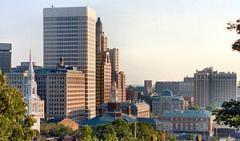
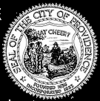
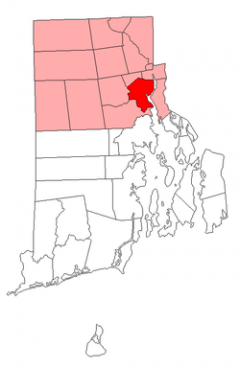
Providence is the capital and most populous city of the state of Rhode Island and was one of the first cities established in the United States. Located in Providence County, it is the third largest city in the New England region. The city proper population of 178,042 anchors the 37th largest metropolitan population in the country, with an estimated MSA population of 1,600,856, exceeding that of Rhode Island by about 60% due to its reaching into southern Massachusetts. This MSA in turn is part of the larger Greater Boston commuting area, which contains 7.6 million people. Situated at the mouth of the Providence River, at the head of Narragansett Bay, the city's small footprint is crisscrossed by seemingly erratic streets and contains a rapidly changing demographic.
Providence was founded in 1636 by Roger Williams, a religious exile from the Massachusetts Bay Colony. He named the area in honor of "God's merciful Providence" which he believed was responsible for revealing such a haven for him and his followers to settle. After being one of the first cities in the country to industrialize, Providence became noted for its jewelry and silverware industry. Today, the City of Providence is home to eight hospitals and seven institutions of higher learning, which has shifted the city's economy into service industries, though it still retains significant manufacturing activity.
Once nicknamed the "Beehive of Industry", Providence began rebranding itself as the "Creative Capital" in 2009 to emphasize its educational resources and arts community. Its previous moniker was "The Renaissance City", although its 2009 poverty rate was still over 22%.
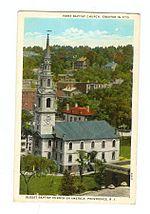
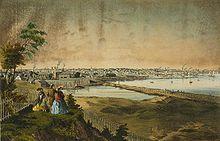
The area that is now Providence was first settled in June 1636 by Roger Williams, and was one of the original Thirteen Colonies of the United States. Although the west bank of the Providence River was later claimed by both the English and the Dutch, the actual inhabitants and true masters of the region were the Pokanoket Tribe of the Wampanoag Nation led by Massasoit Ousamequin. Williams secured permission to settle from the Pokanoket and gave the city its present name. Williams' Providence soon became a refuge for persecuted religious dissenters, as he himself had been exiled from Massachusetts. Providence's growth would be slow during the next quarter-century aethe subsuming of its territory into surrounding towns, difficulty of farming the land, and differing of local traditions and land conflicts all slowed development.
In the mid-1770s, the British government levied taxes that impeded Providence's maritime, fishing and agricultural industries, the mainstay of the city's economy. One example was the Sugar Act, which was a tax levied against Providence's distilleries that adversely affected its trade in rum and slaves. These taxes caused Providence to join the other colonies in renouncing allegiance to the British Crown. In response to enforcement of unpopular trade laws, Providence residents spilled blood in the leadup to the American Revolution in the notorious Gaspee Affair of 1772.
Though during the American Revolutionary War the city escaped British occupation, the capture of nearby Newport disrupted industry and kept the population on alert. Troops were quartered for various campaigns and Brown University's University Hall was used as a barracks and military hospital.
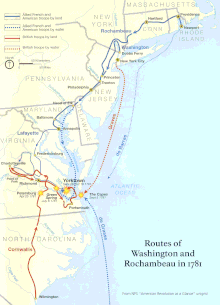
After departing from Newport, French troops sent by King Louis XVI and commanded by the Comte de Rochambeau passed through Providence on their way to join the attack against British forces. The march from Newport to Providence was the beginning of a campaign led jointly by Rochambeau and General George Washington in a decisive march that ended with the defeat of General Cornwallis in the Siege of Yorktown at Yorktown, Virginia and the Battle of the Chesapeake.
Following the war, Providence was the country's ninth-largest cityb[ aº] with 7,614 people. The economy shifted from maritime endeavors to manufacturing, particularly machinery, tools, silverware, jewelry and textiles. By the turn of the twentieth century, Providence boasted some of the largest manufacturing plants in the country, including Brown & Sharpe, Nicholson File, and Gorham Silverware. The city's industries attracted many immigrants from Ireland, Germany, Sweden, England, Italy, Portugal, Cape Verde, and French Canada. Economic and demographic shifts caused social strife, notably with a series of race riots between whites and blacks during the 1820s. In response to these troubles and the economic growth, Providence residents ratified a city charter in 1831 as the population passed 17,000.
During the Civil War, local politics split over slavery as many had ties to Southern cotton. Despite ambivalence concerning the war, the number of military volunteers routinely exceeded quota, and the city's manufacturing proved invaluable to the Union. Postwar, horsecar lines covering the city enabled its growth and Providence thrived with waves of immigrants and land annexations bringing the population from 54,595 in 1865 to 175,597 by 1900.
The city's boom began to wane in the mid-1920s as industries, notably textiles, shut down. Jewelry manufacturing continued to grow, taking up the slack and employing many of the city's new immigrants, coming from Portuguese, Italian, Polish, Lithuanian and Jewish backgrounds. A number of hospitals also opened. The Great Depression hit the city hard, and Providence's downtown was subsequently flooded by the New England Hurricane of 1938. Though the city received a boost from World War II, this ended with the war. The city saw further decline as a result of nation-wide trends, with the construction of highways and increased suburbanization. The population would drop by 38% over the next three decades. From the 1950s to the 1980s, Providence was a notorious bastion of organized crime. The mafia boss Raymond L.S. Patriarca ruled a vast criminal enterprise.
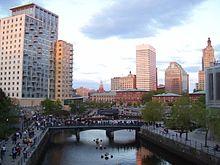
The city's "Renaissance" began in the 1970s. From 1975 until 1982, $606 million of local and national Community Development funds were invested throughout the city, and the hitherto falling population began to stabilize. In the 1990s, Mayor Vincent Cianci, Jr showcased the city's strength in arts and pushed for further revitalization, ultimately resulting in the uncovering of the city's natural rivers (which had been covered by paved bridges), relocation of a large section of railroad underground, creation of Waterplace Park and river walks along the river's banks, and construction of the Fleet Skating Rink (now the Bank of America Skating Rink) downtown and the 1.4 million ft ² Providence Place Mall.
New investment triggered within the city, with new construction including numerous condo projects, hotels, and a new office high-rise all filling in the freed space. Despite new investment, poverty remains an entrenched problem as it does in most post-industrial New England cities. Approximately 22 percent of the city population lives below the poverty line. Recent increases in real estate values further exacerbate problems for those at marginal income levels, as Providence had the highest rise in median housing price of any city in the United States from 2004 to 2005.
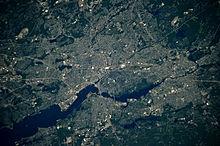
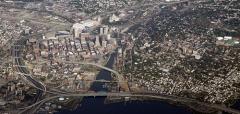
The Providence city limits enclose a small geographic region, with a total area of 20.5 square miles (53 km2). 18.5 square miles (48 km2) of it is land and the remaining 2.1 square miles (5.4 km2) (roughly 10%) of it is water.
Providence is located at the head of Narragansett Bay, with the Providence River running into the bay through the center of the city, formed by the confluence of the Moshassuck and Woonasquatucket Rivers. The Waterplace Park amphitheater and riverwalks line the river's banks through downtown.
Providence is one of many cities claimed, like Rome, to be founded on seven hills. The more prominent hills are: Constitution Hill (near downtown), College Hill (east of the Providence River), and Federal Hill (west of downtown and is New England's largest Italian district outside of Massachusetts). The other four are: Tockwotten Hill at Fox Point, Smith Hill (where the State House is located), Christian Hill at Hoyle Square (junction of Cranston & Westminster Streets), and Weybosset Hill at the lower end of Weybosset Street, which was leveled in the early 1880s.
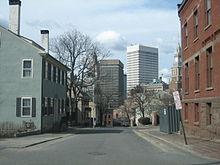
Providence has 25 official neighborhoods, though these neighborhoods are often grouped together and referred to collectively:
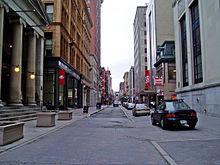
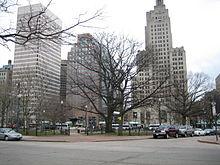
The city of Providence is geographically very compact, characteristic of eastern seaboard cities which developed prior to use of the automobile. It is among the most densely populated cities in the country. For this reason, Providence has the eighth-highest percentage of pedestrian commuters. The street layout is irregular aeover one thousand streets (a great number for the city's size) run haphazardly, connecting and radiating from traditionally bustling places like Market Square.
Downtown Providence has numerous 19th century mercantile buildings in the Federal and Victorian architectural styles, as well as several post-modern and modernist buildings, located throughout the area. In particular, a fairly clear spatial separation appears between the areas of pre-1980s development and post-1980s development. West Exchange Street and Exchange Terrace serve as rough boundaries between the two.
The newer area, sometimes called "Capitol Center", includes Providence Place Mall (1999), a Westin hotel (1993) and The Residences at the Westin (2007), GTECH (2006), Waterplace condominiums (2007), and Waterplace Park (1994); the area tends toward newer development since much of it is land reclaimed in the 1970s from a mass of railroad tracks which was referred to colloquially as the "Chinese Wall". This part of Downtown is characterized by open spaces, wide roads, and intent landscaping.
The historic part of downtown has many streetscapes that look as they did eighty years ago. Many of the state's tallest buildings are found here. The largest structure, to date, is the art-deco-styled former Industrial Trust Tower, currently the Bank of America Building at 426 feet (130 m). By contrast, nearby to it is the second tallest One Financial Plaza, designed in modern taut-skin cladding, constructed a half century later. In between the two is 50 Kennedy Plaza. The Textron Tower is also a core building to the modest Providence skyline. Downtown is also the home of the Providence Biltmore and Westminster Arcade, the oldest enclosed shopping mall in the U.S., built in 1828.
The city's southern waterfront, away from the downtown core, is the location of many oil tanks, a docking station for a ferry boat, a non-profit sailing center, bars, strip clubs, and power plants. The Russian Submarine Museum was located here until 2008, after the submarine sank in a storm and was declared a loss. The Fox Point Hurricane Barrier is also found here, built to protect Providence from storm surge, like that which it had endured in the 1938 New England Hurricane and again in 1954 from Hurricane Carol.
The majority of the cityscape comprises abandoned and revitalized industrial mills, double and triple decker housing (though the row houses found so commonly in other Northeast cities, are notably rare here), a small number of high-rise buildings (predominantly for housing the elderly), and single family homes. I-95 serves as a physical barrier between the city's commercial core and neighborhoods such as Federal Hill and the West End.
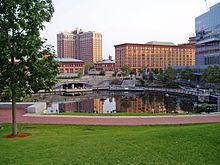
Providence's climate is a humid continental climate, with warm summers, cold winters, and high humidity year-round. The USDA rates the city at Zone 6a, which is an "in-between" climate. The influence of the Atlantic Ocean keeps Providence, and the rest of the state of Rhode Island, warmer than many inland locales in New England. January is the coldest month with a mean of 28.7 °F ( na1.8 °C). July is the warmest month with a mean of 73.3 °F (22.9 °C), with highs rising to 90 °F (32 °C) on 10 days per summer. Extremes range from na17 °F ( na27 °C) in February 1934 to 104 °F (40 °C) in August 1975.
As with the rest of the northeastern seaboard, Providence receives ample precipitation year-round. Monthly precipitation ranges from a high of 4.43 inches (112.5 mm) in March to a low of 3.17 inches (80.5 mm) in July. Precipitation levels are generally slightly lesser in the summer months than the winter months, when powerful storms known as Nor'easters can cause significant snowfall and blizzard conditions. Although hurricanes are not frequent in coastal New England, Providence's location at the head of Narragansett Bay makes it vulnerable to them.
As of the census of 2000, the population comprised 173,618 people, 162,389 households, and 35,859 families. The population density was 9,401.7 inhabitants per square mile (3,629.4/km ²), characteristic of comparatively older cities in New England such as New Haven, Connecticut; Springfield, Massachusetts and Hartford, Connecticut. Also like these cities, its population peaked in the 1940s just prior to the nationwide period of rapid suburbanization.
Providence has had a substantial Italian population since the turn of the century, with 14% (a pluralityc[ aº]) of the population claiming Italian ancestry. Italian influence manifests itself in Providence's Little Italy in Federal Hill. Irish immigrants have also had considerable influence on the city's history, with 8% of residents claiming Irish heritage.
Belying Providence's traditionally white makeup is the sizable minority presence it has acquired in the last twenty years, embodied in the election of its first Latino mayor in 2010, Dominican-American Angel Taveras. Though nearby cities like Boston, Hartford, New Haven, and Springfield have longer-standing black and Latino communities, Providence now surpasses all but Hartford in the density of its minority population, with non-Hispanic whites comprising less than half (37.6%) of the population, down from 89.5% in 1970. Though salient contributions to this growth have been among Asians and unspecified races, the most dramatic change comes from Hispanics, whose presence has increased fivefold. Having origins in Puerto Rico, Colombia, Bolivia, the Dominican Republic, and Central America (particularly Guatemala), Hispanics have strong influence in the neighborhoods of Elmwood, the West End, Upper, and Lower South Providence. Hispanic impact is even larger in the city's schools. Hispanics represent over half (55%) of all students in the city's school system while comprising only 38.1% of Providence's population.
In addition, Providence, like the nearby Massachusetts cities of Fall River and New Bedford, has a considerable community of immigrants from various Portuguese-speaking countries, living mostly in the areas of Washington Park and Fox Point. Portuguese is the city's third-largest nationality, (after Italian and Irish) at 4% of the population while Cape Verdeans make up another 2%.
African Americans constitute 16% of the city with the largest percentages in Mount Hope and Upper and Lower South Providence neighborhoods. Asians are 6% of Providence's population and have enclaves scattered throughout the city. Another 6% of the city has multiracial ancestry. Native Americans and Pacific Islanders make up the remaining 1.3%. With Liberians comprising 0.4% of the population, the city is home to one of the largest Liberian immigrant populations in the country.
The Providence metropolitan area, which includes Providence, Fall River, Massachusetts, and Warwick is estimated to be 1,622,520. In 2006, this area was officially added to the Boston Combined Statistical Area (CSA), the fifth-largest CSA in the country. In the last fifteen years, Providence has experienced a sizable growth in its under-18 population, attributed to the influx of Hispanics. The median age of the city is 28 years, while the largest age cohort is 20 to 24 year olds, owing to the city's large student population.
The per capita income, as of the 2000 census, was $15,525, which is well below both the state average of $29,113, and the national average of $21,587. The median income for a household was $26,867, and the median income for a family in Providence was $32,058, according to the 2000 census. The city has one of the highest rates of poverty in the nation with 29.1% of the population and 23.9% of families living below the poverty line in 2000, the largest concentrations being found in the city's Olneyville, and Upper and Lower South Providence areas. Poverty has affected children at a disproportionately higher rate with 40.1% of those under the age of 18 living below the poverty line, concentrated particularly west of downtown in the neighborhoods of Hartford, Federal Hill, and Olneyville.
Compared to the national average, Providence has an average rate of violent crime and higher rate of property crime per 100,000 inhabitants. In 2010, there were 15 murders, down from 2009's 24. In 2010, Providence fared better regarding violent crime than most of its peer cities: Springfield, Massachusetts, a city with approximately 20,000 fewer residents than Providence, reported 15 murders in 2009 (i.e. the same number of homicides as Providence, but a slightly higher rate per capita); New Haven, Connecticut and Hartford, Connecticut, cities with approximately 50,000 fewer people than Providence, reported, respectively, 24 and 26 murders in 2010, significantly higher murder rates per capita than Providence. The police chief asserted that Providence's violence was not stranger-to-stranger, but relationship driven. The pattern of violent crime was highly specific by neighborhood with vast majority of the murders taking place in the poorer sections of Providence, such as Olneyville, Elmwood, South Providence and the West End.
Providence was one of the first cities to industrialize in the United States. By 1830, the city had manufacturing industries in metals, machinery, textiles, jewelry, and silverware. Though manufacturing has declined, the city is still one of the largest centers for jewelry and silverware design and manufacturing. Services, particularly education, health care, and finance, also make up a large portion of the city's economy. Providence also is the site of a sectional center facility, a regional hub for the U.S. Postal Service. Since it is the capital of Rhode Island, Providence's economy additionally consists of government services.

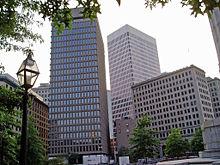
The Fortune 500 conglomerate Textron and Fortune 1000 company Nortek Incorporated are both headquartered in the city, and GTECH's world headquarters has recently been moved to downtown Providence. Citizens Bank, the 15th largest bank in the country, is also headquartered in Providence. Another company whose origins were in the city is Fleet Bank. Once Rhode Island's largest bank, it moved its headquarters to Boston, Massachusetts, after acquiring Shawmut Bank in 1995. Before its acquisition by Bank of America, Fleet merged with BankBoston to become New England's largest commercial bank.
The city is home to the Rhode Island Convention Center, which opened in December 1993. Along with a hotel, the convention center is connected to the Providence Place Mall, a major retail center, through a skywalk. The Port of Providence, the second largest deepwater seaport in New England, handles cargo such as cement, chemicals, heavy machinery, petroleum, and scrap metal.
According to the City's 2009 Comprehensive Annual Financial Report, the top ten employers in the city are:
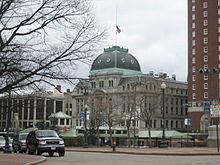
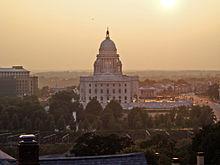
Providence serves as Rhode Island's capital, housing the Rhode Island General Assembly as well as the offices of the Governor and the Lieutenant Governor in the Rhode Island State House.
Providence's city government has a mayor-council form of government. The Providence City Council consists of fifteen city councilors, one for each of the city's wards. The council is tasked with enacting ordinances and passing an annual budget. Providence also has probate and superior courts. The U.S. District Court for the District of Rhode Island is located downtown across from City Hall adjacent to Kennedy Plaza.
David N. Cicilline finished his term as mayor in 2010, 8 years after taking office as the first openly gay mayor of an American state capital. (notably, the second was elected 8 years later in neighboring Hartford, Connecticut.) Providence was the largest American city to have an openly gay mayor, until Sam Adams took office in Portland, Oregon on January 1, 2009.
The city's first Latino mayor was elected in 2010, Angel Taveras, who assumed office January 3, 2011.
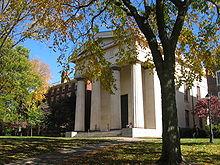
The flagship campuses of five of Rhode Island's colleges and universities are in Providence (city proper):
In addition, the Community College of Rhode Island (Downcity and Liston campuses), Roger Williams University (Providence campus) and University of Rhode Island (Providence campus) have satellite campuses in the city. Between these schools the number of postsecondary students is approximately 44,000. Compounded by Brown University's being the second-largest employer, higher education exerts a considerable presence in the city's politics and economy.
Several private schools, including Moses Brown, the Lincoln School, and the Wheeler School, are in the city's East Side. LaSalle Academy is located in the Elmhurst area of the city near Providence College. The public charter schools Time Squared Academy (K-12) and Textron Chamber of Commerce (9 ae12) are funded by GTECH and Textron respectively. In addition, the city's South Side houses Community Preparatory School, a private school serving primarily low-income students in grades 3 ae8. Within the semi-private schools, The Metropolitan Regional Career and Technical Center (The Met) and The Big Picture Company schools serve students through real world experiences and project-based learning. There are two separate centers for students with special needs.
The Providence Public School District serves about 30,000 students from pre-Kindergarten to grade 12. The district has 25 elementary schools, nine middle schools, and thirteen high schools. The Providence Public School District features magnet schools at the middle and high school level, Nathanael Greene and Classical respectively. The overall graduation rate as of 2007 is 70.1%, which is close to the statewide rate of 71% and the national average of 70%.
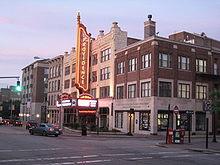
Much of Providence culture is synonymous with Rhode Island culture. Like the state, the city has a non-rhotic accent which can be heard on local media. Providence also shares Rhode Island's affinity for coffee, as the former has the most coffee/doughnut shops per capita of any city in the country. Providence, like many other towns, is also reputed to have the highest number of restaurants per capita, many of which are founded and/or staffed by its own Johnson & Wales University graduates.
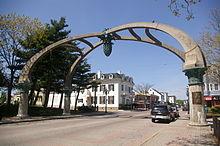
Providence has several ethnic neighborhoods, notably Federal Hill and the North End (Italian), Fox Point (Portuguese), West End (mainly Central American and Asians), and Smith Hill (Irish with miscellaneous enclaves of other groups). There are also many dedicated community organizations and arts associations located in the city.
The city gained the reputation as one of the most active and growing gay communities in the Northeast; the rate of reported gay and lesbian relationships is 75% higher than the national average and Providence has been named among the "Best Lesbian Places to Live". The former mayor, David Cicilline, won his election running as an openly gay man, making him the first openly gay mayor of a U.S. state capital. Former Mayor Cianci instituted the position of Mayor's Liaison to the Gay and Lesbian community in the 1990s. Providence is home to the largest gay bathhouse in New England.
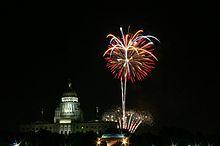
During the summer months, the city regularly hosts WaterFire, an environmental art installation that consists of about 100 bonfires that blaze just above the surface of the three rivers that pass through the middle of downtown Providence.[100] There are multiple Waterfire events that are accompanied by various pieces of classical and world music. The public art displays, most notably sculptures, change on a regular basis.
The city is also the home of the Tony Award-winning theater group Trinity Repertory Company, the Providence Black Repertory Company, and the Rhode Island Philharmonic Orchestra,[101] as well as groups like The American Band, once associated with noted American composer D. W. Reeves. Providence is also the home of several performing arts centers such as the Veterans Memorial Auditorium, the Providence Performing Arts Center, and the Providence Festival Ballet. The city's underground music scene, centered around artist-run spaces such as the now-defunct Fort Thunder, is known in underground music circles.[102]
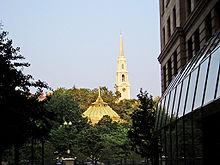
Providence is home to an 1,200-acre (4.9 km2) park system,[103] notably Waterplace Park and Riverwalk, Roger Williams Park, Roger Williams National Memorial, and Prospect Terrace Park, the latter featuring expansive views of the downtown area. As one of the first cities in the country, Providence contains many historic buildings while the East Side neighborhood in particular includes the largest contiguous area of buildings listed on the National Register of Historic Places in the U.S. with many pre-revolutionary houses.[104] The East Side is also home to the First Baptist Church in America, the oldest Baptist church in the Americas, founded by Roger Williams in 1638, as well as the Old State House, which served as the state's capitol from 1762 to 1904.[105] Nearby is Roger Williams National Memorial. Downcity Providence is home to the fourth largest unsupported dome in the world (the second largest marble dome after St. Peter's Basilica in Rome),[106] as well as the Westminster Arcade, which is the oldest enclosed shopping center in the U.S.[107][108]
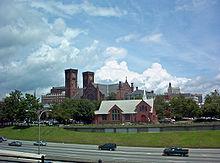
The main art museum is the Rhode Island School of Design Museum, which has the twentieth largest collection in the country.[109] In addition to the Providence Public Library and its nine branches, the city is home to the Providence AthenR¦um, the fourth oldest library in the country.[110] Here, on one of his many visits to Providence, Edgar Allan Poe, met and courted a love interest named Sarah Helen Whitman.[111] Poe was a regular fixture there, as was H. P. Lovecraft (who was born in Providence); both of them influential writers of gothic literature.
The Bank of America Skating Center, formerly the Fleet Skating Center, is located near Kennedy Plaza in the downtown district, connected by pedestrian tunnel to Waterplace Park, a cobblestone and concrete park below street traffic that abuts Providence's three rivers.[112][113]
The southern part of the city is home to the famous roadside attraction Nibbles Woodaway (also known as the "Big Blue Bug"), the world's largest termite,[114] as well as the aforementioned Roger Williams Park, which contains a zoo, a botanical center, and the Museum of Natural History and Planetarium.[115]
The city is home to the American Hockey League team Providence Bruins, which plays at the Dunkin' Donuts Center (formerly the Providence Civic Center). From 1926 to 1972, the AHL's Providence Reds (renamed the Rhode Island Reds in their last years)[116] played at the Rhode Island Auditorium. In 1972, the team relocated to the Providence Civic Center, where they played until moving to Binghamton, New York, in 1977.
The city is home to the Rugby League team Rhode Island Rebellion, which plays at Classical High School. The Rhode Island Rebellion is a member of the USA Rugby League (USARL).[117] The Rhode Island Rebellion recognizes its mission to serve club members, the State of Rhode Island and the Country. Its dual focus is to provide an opportunity for interested persons to participate in organized activities to achieve their maximum athletic and skillful potential in Rugby League, and to provide Rhode Islanders with an Exciting Team to become a part of. Its inaugural season began June 4, 2011.[118][119]Rebellion's Website
The NFL's New England Patriots and MLS's New England Revolution play in Foxborough, Massachusetts, which is situated halfway between Providence and Boston. Providence was formerly home to two major league franchises: the NFL's Providence Steam Roller in the 1920s and 1930s, and the NBA's Providence Steamrollers in the 1940s. The city is also where Rocky Marciano won 29 of his 49 fights.[120]
The city's defunct baseball team, the Providence Grays, competed in the National League from 1879 through 1885. The team defeated the New York Metropolitans in baseball's first successful "world championship series" in 1884.[121] In 1914, after the Boston Red Sox purchased Babe Ruth from the then-minor league Baltimore Orioles, the team prepared Ruth for the major leagues by sending him to finish the season playing for a minor league team in Providence that was also known as the Grays. Today, professional baseball is offered by the Pawtucket Red Sox, the AAA affiliate of the Boston Red Sox which plays in nearby Pawtucket. Most baseball fans aealong with the local media aetend to follow the Boston Red Sox.[122]
Major colleges and universities fielding NCAA Division I athletic teams are Brown University and Providence College. The latter is a member of the Big East Conference. Much local hype is associated with games between these two schools or the University of Rhode Island. Providence has also hosted the alternative sports event Gravity Games from 1999 to 2001, and was also the first host of ESPN's X Games, known in its first edition as the Extreme Games, in 1995. Providence has its own roller derby league. Formed in 2004, it currently has four teams: the Providence Mob Squad, the Sakonnet River Roller Rats, the Old Money Honeys, and the Rhode Island Riveters.
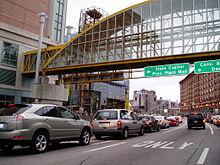
Providence is home to eight hospitals, most prominently Rhode Island Hospital, the largest general acute care hospital in the state. It is also the Level I Trauma Center for Rhode Island, Southeastern Massachusetts and parts of Connecticut.[123] The hospital is in a complex along I-95 that includes Hasbro Children's Hospital and Women and Infants Hospital. The city is also home to the Roger Williams Medical Center, St. Joseph Hospital For Specialty Care (a division of St. Joseph Health Services Of Rhode Island), The Miriam Hospital, a major teaching affiliate associated with the Alpert Medical School of Brown University, as well as a VA medical center.
The Rhode Island Blood Center has its main headquarters in Providence. Since 1979, the Rhode Island Blood Center has been the sole organization in charge of blood collection and testing and distribution of blood products to 11 hospitals in Rhode Island.
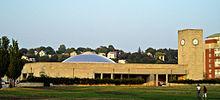
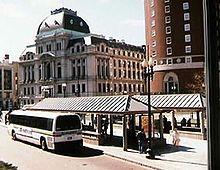
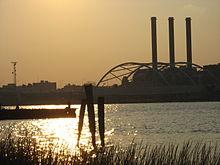
Providence is served by air primarily by the commercial airfield T. F. Green Airport in nearby Warwick. General aviation fields also serve the region. Because of overcrowding and Big Dig complications in Boston, Massport has been promoting T.F. Green as an alternative to Boston's Logan International Airport.[124]
Providence Station, located between the Rhode Island State House and the downtown district, is served by Amtrak[125] and MBTA Commuter Rail services, with a commuter rail route running north to Boston and south to a recently opened station at T.F. Green Airport and Wickford Junction.[126][127] Approximately 2400 passengers daily pass through the station.[128][129]
I-95 runs from north to south through Providence while I-195 connects the city to eastern Rhode Island and southeastern Massachusetts, including New Bedford, Massachusetts, and Cape Cod. I-295 encircles Providence while RI 146 provides a direct connection with Worcester, Massachusetts. The city has commissioned and begun a long-term project, the Iway, to move I-195 not only for safety reasons, but also to free up land and to reunify the Jewelry District with Downcity Providence, which had been split from one another by the highway.[130] The project is estimated to cost $446 million and be completed in 2012.[131]
Kennedy Plaza, in downtown Providence, serves as a transportation hub for local public transit as well as a departure point for Peter Pan[132] and Greyhound[133] bus lines. Public transit is managed by Rhode Island Public Transit Authority (RIPTA).[134] Through RIPTA alone Kennedy Plaza serves over 71,000 people a day.[135] The majority of the area covered by RIPTA is served by traditional buses. Of particular note is the East Side Trolley Tunnel running under College Hill, the use of which is reserved for RIPTA buses. RIPTA also operates the Providence LINK, a system of tourist trolleys in downtown Providence. From 2000 to 2008, RIPTA operated a seasonal ferry to Newport between May and October.
Electricity and natural gas are provided by National Grid.[136] Providence Water is responsible for the distribution of drinking water, ninety percent of which comes from the Scituate Reservoir about ten miles (16 km) west of downtown, with contributions coming from four smaller bodies of water. Drinking water in Providence has been rated among the highest quality in the country.[137][138][139][140]
Providence has four sister cities designated by Sister Cities International:[141]
^ b: Providence was listed as a town (not a city) by the US Census Bureau until the Census of 1840. This is because in all the New England states, city status is conferred by the form of government, not population. Providence retained the title of ninth-largest settlement until the Census of 1810.
Word Count: 6125







